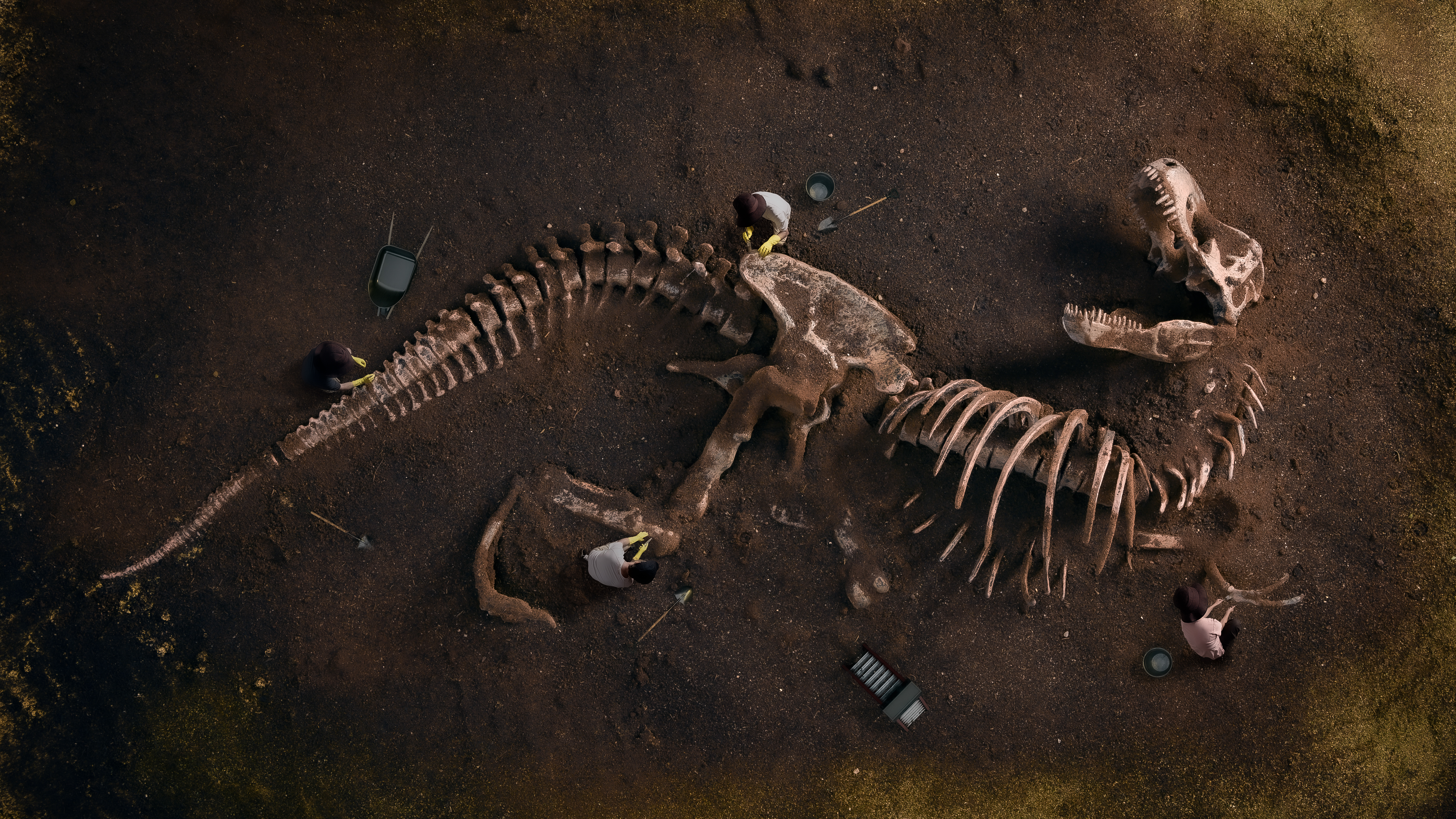All About Dinosaurs and Fossils

By: FUN Monster
It's a well-known fact that long before humanity came along, dinosaurs ruled Earth. What many people don't realize, however, is that it truly was the entire planet. Dinosaur fossils have been found on every continent around the globe, even deep within the frozen landscape of Antarctica. While the majority of them have been discovered in Argentina, China, and North America, there may be dinosaur fossils buried deep below where you are right now.
- The Age of Dinosaurs
- The Surprising History (and Future) of Dinosaurs
- Dinosaur Facts from the American Museum of Natural History
- When Did Dinosaurs Live?
- The Strange Lives of Polar Dinosaurs
What Is a Fossil?
A fossil can be any form of preserved remains left behind by a once-living organism from a former geological era. Most people associate fossils with dinosaurs, but the term can be applied to the remains of any animal or plant that was once alive. Some of the most common examples of fossils discovered include shells, bones, imprints, and even organisms preserved in amber like the iconic mosquito from Jurassic Park .
How Are Fossils Formed?
Most fossils are formed when an animal dies and is very soon after covered by sediment. As the buried body decays over time, it leaves a lasting impression in the ground that's eventually filled with rock. However, this is just one of several ways that fossils can be formed. Fossils come in a variety of types, and the way they're formed varies.
Types of Fossils
Mold and Cast Fossils (Stone Fossils)
Mold and cast fossils are the most common types of fossils and are usually what people imagine a fossil looking like. They're created when the remains of an animal or plant are buried and, over the years, leave an impression deep within the ground. This impression is slowly filled with minerals over time that eventually turn to stone and leave behind a cast of the skeleton. These types of fossils are the ones commonly put on display in the form of dinosaur skeletons.
Here's a step-by-step look at exactly how mold and cast fossils are formed:
- A dinosaur, or any other type of animal, dies in a river, and its body sinks below the water.
- The dinosaur's body then decomposes or is eaten by other animals, leaving behind only its skeleton.
- Sediment, such as mud and sand, covers the bones.
- As time passes, the sediment covering the skeleton is turned into rock.
- The dinosaur bones encapsulated within the newly formed rock deteriorate and leave behind a perfect impression of the skeleton. This is where the term "mold" in "mold and cast fossils" comes from.
- Tiny bits of rock and minerals carried along by groundwater slowly fill the skeleton mold over millions of years.
- Once the mold is filled, the tiny individual bits of rock are compressed together over time and become solid rock.
- The fossil is then brought to the surface through natural occurrences, such as rising mountains or earthquakes, and it's eventually discovered, either due to weathering or excavations conducted by paleontologists.
Whole Animal Fossils
While animal skeletons preserved in the form of mold and cast fossils are the most common type, entire animal fossils have been discovered as well. These whole animal fossils are created when the animal either becomes frozen in ice or trapped inside tree sap, which then turns to amber over the years. Both of these processes preserve the animal just as it was when it became trapped and not just as its decomposed remains. Several insects have been found preserved in amber, and paleontologists have even discovered woolly mammoths frozen in ice.
- Remarkable Fossil Features an Insect Trapped in Amber, Stuck to a Dinosaur Jaw
- Trapped in Time: The Top Ten Amber Fossils
- 100-Million-Year-Old Crab Preserved in Amber
Petrified Wood Fossils
Another type of fossil is petrified wood. This is wood that has turned into stone over the course of millions of years. Though the exact process by which this happens is still being researched, it's hypothesized that it is due to a lack of oxygen when plants die. Scientists believe that the petrification process begins when a plant becomes buried by the sediment at the bottom of a river, not unlike mold and cast fossils. The minerals in the sediment then seep into the open spaces within the wood and preserve it, allowing it to slowly turn into a fossil over time.
How Long Do Fossils Take to Form?
The processes for mold and cast fossils, insects in amber, and petrified wood take a long, long time. These types of fossils generally take millions of years to properly form. Whole animal fossils, on the other hand, are formed much faster. These fossils are generally so well-preserved that their very existence implies that it's a relatively fast process. In general, the time it takes to form a whole animal fossil is only as long as it takes for the water or sap around the animal to solidify.
Where and How Are Fossils Discovered?
Fossils can be found all over the planet, from arid deserts to frozen tundras. Many of them are discovered when the rock surrounding the fossil is brought to the surface by earthquakes or similar events, where it's eventually weathered away by rain and wind to reveal the fossil within. Other fossils are discovered by paleontologists who embark on scientific digs to find them.
Near Water
One of the most common places fossils are found is in the sedimentary rock near bodies of water. These rock formations are made from the clay, mud, silt, and sand in oceans, lakes, rivers, and swamps that have turned to stone over millions of years. These types of fossils are created when the body of a deceased animal is buried underwater by moving sediment.
Ice
Whole animal fossils are most commonly discovered in ice because it's able to preserve the entire body so effectively. Entire woolly mammoths have been discovered frozen in ice in Siberia.
Forests
Another common place where fossils are found is in forests. The types of fossils most commonly found in these areas are petrified wood and insects encased in amber. Other fossil discoveries in forests throughout the years have included tree frogs that are millions of years old and even an ancient village partially preserved in petrified wood.
Dinosaurs, Paleontology Studies, and More!
- How to Become a Paleontologist: This in-depth page explains what a paleontologist does and how to become one.
- Fossil Gallery: View an extensive online gallery featuring images of fossils that can be explored by animal type, plant type, and time period.
- Dinosaurs: Facts and Fiction: Learn interesting facts about dinosaurs, like how long one could live, what the biggest dinosaur was, and much more.
- Texas Fossils: Browse images on this site that can help you identify fossils.
- Vertebrate Paleontology Collection at the Florida Museum of Natural History: Learn about Cenozoic fossils found in Florida and beyond here.
- The Palaeontological Association: Groups like this British organization support the study of paleontology.
- Why Study Paleontology? The Anza-Borrego Desert Paleontology Society looks at why someone should study paleontology.
- La Brea Tar Pit Virtual Tour: Take a self-guided tour of one of the most famous fossil sites in the world from comfort of your own home.
- Fossils Disguised in the Architecture of Washington, D.C.: This website highlights buildings throughout Washington, D.C., that accidentally used fossils in their construction.
- Dinosaurs, Fossils, and Paleontology: They Rock! An informational page from the Berkshire Museum digs into myths and facts about dinosaurs and fossils.
- Fossils of Kentucky: Take a comprehensive look at some of the most interesting fossils uncovered in Kentucky.
- Dinosaur Fossils in Maryland: Read about some of the prehistoric fossils found in the state of Maine.
- Dinosaur Walk: Explore this large collection of information about several dinosaur species.
- Biology of Dinosaurs: Fossil Evidence: This educational article gives an overview of dinosaurs as a whole.
- Quick Guide to Common Fossils: Use this collection of resources to help you identify fossils.
- How to Identify if You Have a Fossil: This page will help you determine if what you have is just a rock or a genuine fossil.

